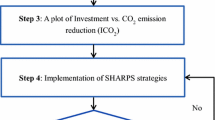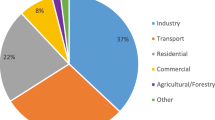Abstract
A new procedure for environmental targeting of co-generation system is presented. The proposed method is based on the concepts of pinch technology for total site targeting of fuel, power, steam, environmental impacts and total annualized cost with considering emissions taxes. This approach provides a consistent, general procedure for determining mass flow rates and efficiencies of the applied turbines. This algorithm utilizes the relationship of entropy with enthalpy and isentropic efficiency. Also, the life cycle assessment (LCA) as a well-known tool for analyzing environmental impacts on a wide perspective with reference to a product system and the related environmental and economic impacts have been applied. In this regard, a damage-oriented impact analysis method based on Eco-indicator 99 and footprints analysis was considered. In addition, the present work demonstrates the effect of including both sensible and latent heating of steam in the extended Site Utility Grand Composite Curve (ESUGCC). It is shown that including sensible heating allows for better thermal matching between the processes. Furthermore, the other representation YSUGCC as the other form of Site Utility Grand Composite has been proposed. Two case studies were used to illustrate the usefulness of the new environmental targeting method.
Similar content being viewed by others
References
V. R. Dhole and B. Linnhoff, Comput. Chem. Eng., 17, 101 (1993).
K. Raissi, Total site integration, PhD Thesis, UMIST, Manchester (1994).
J. Klemes, V.R. Dhole, K. Raissi, S. J. Perry and L. Puigjaner, Appl. Thermal Eng., 17(8–10), 993 (1997).
M. Sorin and A. Hammache, Appl. Thermal Eng., 25, 961 (2005).
S. P. Mavromatis and A. C. Kokossis, Chem. Eng. Sci., 53(8), 1585 (1998).
D. A. Harell, Resource conservation and allocation via process integration, Ph.D. Thesis, Texas A&M University (2004).
P. S. Varbanov, S. Doyle and R. Smith, Chem. Eng. Res. Design, 82(5), 561 (2004).
T. Mohan and M.M. El-Halwagi, Clean Technol. Environ. Policy, 9(1), 13 (2007).
J.M. Medina-Flores and M. Picón-Núñez, Chem. Eng. Sci., 65(9), 2811 (2010).
S. Bandyopadhyay, J. Varghese and V. Bansal, Appl. Thermal Eng., 30, 6 (2010).
A. Ghannadzadeh, S. Perry and R. Smith, Chem. Eng. Transactions, 25, 917 (2011).
A. Ghannadzadeh, S. Perry and R. Smith, Appl. Thermal Eng., DOI: 10.10.1016/j.applthermaleng.2011.10.006 (2011).
A. Kapil, I. Bulatov, R. Smith and J.-K. Kim, Chem. Eng. Res. Design, DOI:10.1016/j.cherd.2011.09.001 (2010).
P. S. Varbanov and J. Klemes, Comput. Chem. Eng., 35, 1815 (2011).
P. Y. Liew, S. R. Wan Alwi, P. S. Varbanov, Z. A. Manan and J. Klemes, Appl. Thermal Eng., 40, 397 (2012).
P. S. Varbanov, Z. Fodor and J. J. Klemeš, Energy, DOI:10.1016/ j.energy.2011.12.025 (2012).
Z. Fodor, J. Klemes, P. S. Varbanov, M. R.W. Walmsley, M. J. Atkins and T. Walmsley, Chem. Eng. Transactions, 29, 409 (2012).
R. Hackl and S. Harvey, Chem. Eng. Transactions, 29, 73 (2012).
N. E. Mohammad Rozali, S.R. Wan Alwi, Z. Abdul-Manan and J. J. Klemeš, Chem. Eng. Transactions, 29, 121 (2012).
A. Nemet, J. Klemes and Z. Kravanja, Energy, 45, 264 (2012).
W. Tjan, R. R. Tan and D. C.Y. Foo, J. Cleaner Production, 18, 848 (2010).
EPA, Environmental Protection Agency. http://www.epa.gov/climatechange/ (accessed APRIL 2012).
M. Gadallaa, Z. Olujic, P. Jansens, M. Jobson and R. Smith, Environ. Sci. Technol., 39(17) (2005).
I. Dincer and M. A. Rosen, Exergy: energy, environment and sustainable development, Elsevier (2007).
G. Stupara, D. Tucakovia, T. Živanovia, M. Banjaca, S. Beloševib, V. Beljanskib, I. Tomanovib, N. Crnomarkovib and M. Sijerib, The influence of primary measures for reducing NO x emissions on energy steam boiler efficiency, Proceedings of ECOS 2012 — the 25th International Conference on Efficiency, Cost, Optimization, Simulation and Environmental Impact of Energy Systems, (125) 1–13, June 26–29, 2012, Perugia, Italy (2012).
International Organization for Standardization (ISO): Environmental management-life cycle assessment. European Standard ENISO14040 and 14044, Geneva (2006).
J. Dewulf and H. Van Langenhove, Environ. Sci. Pollut. Res., 9(4), 267 (2002).
R. R. Tan and D. C. Y. Foo, Energy, 32, 1422 (2007).
M. J. Atkins, A. S. Morrison and M. R.W. Walmsley, Appl. Energy, 87, 982 (2010).
D. Crilly and T. Zhelev, Energy, 33, 1498 (2008).
D. Crilly and T. Zhelev, An emergy-based targeting technique for treatment and utilisation of greenhouse gas emissions, In: Novosad, J. (Ed.), Paper Presented in the 18th International Congress of Chemical and Process Engineering (CHISA) — Summary 4: PRES 2008 and System Engineering, 4, 1214 (2008).
S. Bandyopadhyay, D. C.Y. Foo and R. R. Tan, AIChE J., 56(5), 1235 (2009).
S. C. Lee, D. K. S. Ng, D.C.Y. Foo and R. R. Tan, Appl. Energy, 86, 60 (2009).
R. R. Tan, D. C. Y. Foo and D. K. S. Ng, J. Cleaner Production, 17(10), 940 (2009).
W. Tjan, R. R. Tan, D. C.Y. Foo, J. Cleaner Production, 18, 848 (2010).
L. Cucek, J. Klemes and Z. Kravanja, J. Cleaner Production, 34, 9 (2012).
R. E. H. Ooi, D. C.Y. Foo, D. K. S. Ng and R. R. Tan, Chem. Eng. Transactions, 29, 415 (2012).
L. Èuèek, P. S. Varbanov, J. J. Klemeš and Z. Kravanja, Chem. Eng. Transactions, 29, 61 (2012).
J. Klemes, F. Friedler, I. Bulatov and P. Varbanov, Sustainability in the process industry: integration and optimization, McGraw-Hill, New York (2010).
N. A. AL-Azri, Integrated approaches to the optimization of process-utility systems, Ph.D. Thesis, Texas A&M University (2008).
R. Smith, Chemical Process Design and Integration, Wiley, West Sussex (2005).
C. Monfreda, M. Wackernagel and D. Deumling, Land Use Policy, 21, 231 (2004).
M. A. J. Hujbregts, S. Hellweg and R. Frischknecht, Ecological Economics, 64, 798 (2008).
L. D. Benedetto and J. Klemes, J. Cleaner Production, 17, 900 (2009).
L. Meyer, G. Tsatsaronis, J. Buchgeister, L. Schebek, Energy Int. J., 34, 75 (2009).
A. Boyano, A.M. Blanco-Marigorta, T. Morosuk and G. Tsatsaronis, Energy Int. J., DOI:10.1016/j.energy.2010.05.020 (2010).
Sima Pro, User’s Manual. Pre Consultants BV, Amersfoort (NL) (2007).
A. Nemet, J. Klemes and Z. Kravanja, Energy, 45, 264 (2012).
INDEX MUNDI, www.indexmundi.com/commodities/?commodity=petroleum-price-index (2012).
G.D. Ulrich and P.T. Vasudevan, How to Estimate Utility cost Chemical Engineering, www.che.com/technical_and_practical/2798.html (2006).
Chemical Engineering Economic Indicators, 2012. www.che.com/business_and_economics/economic_indicators.html.
Aguilar O. Design and optimization of flexible utility systems. PhD Thesis, The University of Manchester, Manchester, UK (2005).
GTPRO 18, Thermal Engineering Software for the Power Industry, Thermoflow, Inc., U.S.A. (2008).
STAR Software, Version 2, Center for Process Integration, School of Chemical Engineering & Analytical Science, University of Manchester, UK, Under license of K.N.Toosi University of Technology, Energy and Process Integration Laboratory.
Author information
Authors and Affiliations
Corresponding author
Rights and permissions
About this article
Cite this article
Manesh, M.H.K., Abadi, S.K., Amidpour, M. et al. New emissions targeting strategy for site utility of process industries. Korean J. Chem. Eng. 30, 796–812 (2013). https://doi.org/10.1007/s11814-012-0218-6
Received:
Accepted:
Published:
Issue Date:
DOI: https://doi.org/10.1007/s11814-012-0218-6




